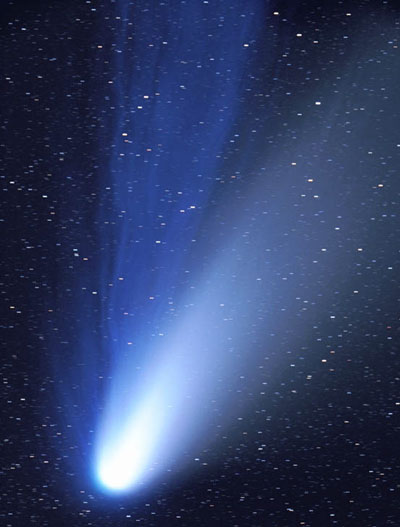
|
Credit & Copyright: John Gleason
(Celestial Images)
Explanation:
In 1977,
Comet Hale-Bopp's intrinsic
brightness exceeded any comet since
1811.
Since it peaked on the other side of the Earth's orbit,
however, the comet appeared only brighter
than any comet in
two decades.
Visible above are the
two tails shed by
Comet Hale-Bopp.
The
blue ion tail is composed of ionized gas molecules,
of which
carbon monoxide particularly glows blue when reacquiring
electrons.
This tail is created by the particles from the fast
solar wind interacting
with gas from the comet's head.
The blue
ion tail points directly away from the
Sun.
The white
dust tail is created
by bits of grit that have come off the
comet's nucleus
and are being pushed away by the
pressure of light from the Sun.
This tail points nearly away from the Sun.
The
above photograph was taken in March 1997.
|
January February March April May June July August September October November December |
| ||||||||||||||||||||||||||||||||||||||||||||||||
NASA Web Site Statements, Warnings, and Disclaimers
NASA Official: Jay Norris. Specific rights apply.
A service of: LHEA at NASA / GSFC
& Michigan Tech. U.
Based on Astronomy Picture
Of the Day
Publications with keywords: comet - dust - tail - Comet Hale-Bopp
Publications with words: comet - dust - tail - Comet Hale-Bopp
See also:
- APOD: 2025 September 30 Á Comet Lemmon Brightens
- APOD: 2025 September 29 Á Two Camera Comets in One Sky
- APOD: 2025 September 26 Á A SWAN an ATLAS and Mars
- APOD: 2025 September 18 Á Comet C/2025 R2 SWAN
- APOD: 2025 September 16 Á New Comet SWAN25B over Mexico
- APOD: 2025 August 28 Á Galaxies, Stars, and Dust
- APOD: 2025 July 7 Á Interstellar Comet 3I ATLAS
